- Quick Read
- Deep Read ( 7 Min. )
In Today’s Issue
- Can US be honest broker in Israeli-Palestinian conflict?
- Equal pay for equal work in Europe? The key may be transparency.
- From LA jail, two inmates pioneer care for mentally ill peers
- Ponytails and braids: Signs of a more inclusive US military
- Traveling (at last)? Take along the 10 best books of May.
Monitor Daily Podcast
- Follow us:
- Apple Podcasts
- Spotify
- RSS Feed
- Download
TODAY’S INTRO
In West Virginia, finding hope for those leaving prison
 Mark Sappenfield
Mark Sappenfield
In prison, inmates make an average of 100 decisions a day, Bev Sharp says. For those on the outside, the average is about 30,000. “In prison, everything is decided for you,” she tells the “100 Days in Appalachia” podcast. Simply making decisions is a skill that can be lost. And that points to how incarceration is not simply a matter of walls and bars, but a mental state that can linger after prison doors open.
In today’s issue, Francine Kiefer examines how two inmates in a Los Angeles jail help others struggling with mental health issues. Ms. Sharp aims to help West Virginians when they leave prison. In 2015, she helped the state’s Council of Churches start a reentry program. Its goal is connection, and workers like Jeremiah Nelson are on the front line.
In so many ways, success in society depends on networks of connection and support. Finding housing, for example, can be so hard that some people simply stay in prison. “You can just sit in prison for no other reason than you have no place to go,” he says. But the deeper aim is to kindle those connections into genuine opportunity – when former prisoners see a purpose and a future. “The biggest inhibitor for a lot of people is a lack of hope,” says Mr. Nelson. “The biggest contributor to recidivism is giving up hope.”
Share this article
Link copied.

Help fund Monitor journalism for $11/ month
Already a subscriber? Login

Monitor journalism changes lives because we open that too-small box that most people think they live in. We believe news can and should expand a sense of identity and possibility beyond narrow conventional expectations.
Our work isn't possible without your support.
Can US be honest broker in Israeli-Palestinian conflict?
President Joe Biden has called for a cease-fire between Israel and Hamas, but there’s little sense the U.S. is an equal broker in the conflict. Nor has it been for decades.

As the deadly exchanges of rocket fire and airstrikes between Israel and Hamas in Gaza entered their second week Monday, the White House issued a statement in which for the first time President Joe Biden expressed his support for a “cease-fire” in the hostilities.
But Mr. Biden also “reiterated his firm support for Israel’s right to defend itself against indiscriminate attacks.” That’s according to a readout of a presidential call with Israeli Prime Minister Benjamin Netanyahu.
Diplomats and regional experts call Mr. Biden’s approach “giving Israel space” to bludgeon Hamas – which the U.S. considers a terrorist organization – and to degrade its offensive capabilities.
Still, once a cease-fire occurs, the Biden administration will likely find it has to adopt a higher profile in seeking to mediate the conflict than it originally intended. The test comes amid a new reality where the U.S. is no longer the dominant power it once was.
“The motto is still very much ‘peace can’t happen without the U.S.,’” says Hugh Lovatt, in the London office of the European Council on Foreign Relations. “But nor can it happen with only the U.S.”
Can US be honest broker in Israeli-Palestinian conflict?

As the deadly exchanges of rocket fire and airstrikes between Israel and Hamas in Gaza entered their second week Monday, the White House issued a statement in which for the first time President Joe Biden expressed his support for a “cease-fire” in the hostilities.
But as if to rule out any doubts about where Mr. Biden stands, the readout of the president’s second call with Israeli Prime Minister Benjamin Netanyahu in three days also “reiterated his firm support for Israel’s right to defend itself against indiscriminate attacks.”
The use of the term “cease-fire” indicated a slight evolution in the president’s outlook on the conflict. But the absence of any pressure to actually end hostilities also suggested that Mr. Biden remains firmly planted in his unblinking and careerlong support for Israel.
Diplomats and regional experts call Mr. Biden’s approach “giving Israel space” to bludgeon Hamas – which the U.S. considers a terrorist organization – and to degrade its offensive capabilities and forces before applying any pressure to end the fighting.
This American green light to Israel is not new, even though it may have shined brightest under an unabashedly one-sided President Donald Trump, analysts say. But it is just one element in a steady deterioration of the ability of the United States to play its traditional role of mediator in the Israeli-Palestinian conflict.
“The honest broker role has been eroding for a lot longer than we’ve been willing to acknowledge,” says Bruce Jentleson, who was a State Department senior adviser on Middle East issues during the Obama administration and is now a professor of public policy at Duke University in North Carolina.
Noting that the Palestinians didn’t trust President George W. Bush and the Israelis openly undermined President Barack Obama, he says “Trump blew up the ‘honest broker’ role big time, but the truth is, it wasn’t in good shape before him” – and really hasn’t been, he adds, since President Bill Clinton.
In his initial months in office, Mr. Biden has demonstrated a desire to shift attention and resources away from the Middle East – even as the U.S. comes to grips with the reality that it is no longer the unrivaled superpower in a region where it faces the growing influence of lesser powers like Russia and Iran.
Yet despite this evolution, the U.S. remains the sole power with any ability to play an influential leadership role in the Israeli-Palestinian conflict. What all this means, Professor Jentleson says, is that while the U.S. can “orchestrate, convene and coordinate” in a region with lots of players with often conflicting interests, “the U.S. can no longer be calling the shots.”
Moreover, it also means that once a cease-fire in the current fighting is reached, the Biden administration will very likely find it has to invest more political capital than it originally intended in a conflict that has dogged administrations for decades.
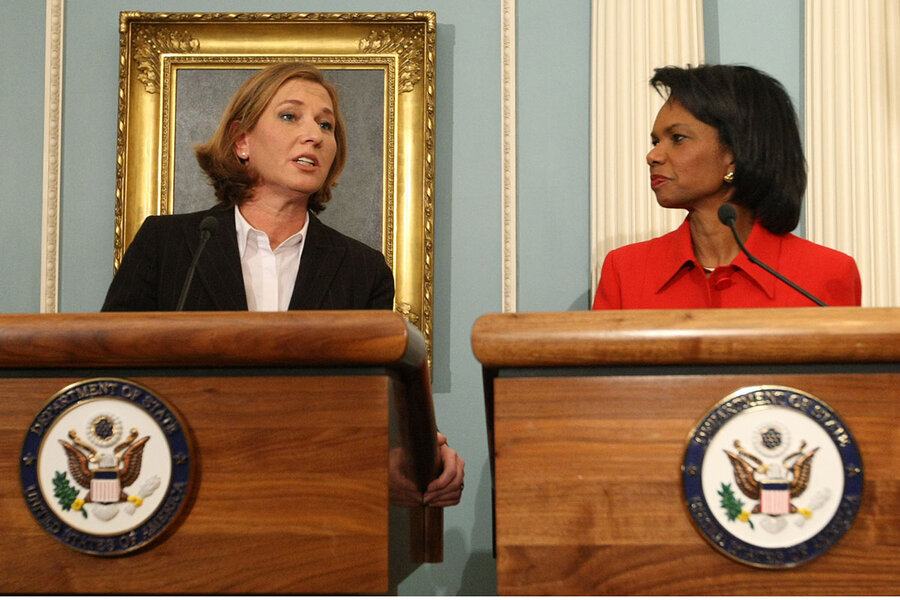
For some, the current “space” that President Biden is extending to Israel harks back to the support Condoleezza Rice, as secretary of state under President Bush, initially offered Israel during the 2009 violence between Hamas and Israel.
“This is not the Biden template; this is actually the classic American template” and a “return to the established U.S. policy in these kinds of situations that preceded Trump,” says Ghaith al-Omari, a senior fellow at the Washington Institute for Near East Policy and a former adviser to Palestinian negotiators at Clinton administration-era peace talks.
What does mediating mean?
Noting that “there’s only so much space the U.S. can give” before pressures mount – particularly over rising civilian casualties – he says “the Jordanians, the Egyptians, Turkey, the Palestinians and others are watching to see: Is the U.S. capable … of taking leadership” while demonstrating an understanding that “leadership doesn’t necessarily mean monopoly, it means the ability to mobilize other actors.”
After eight days of fighting, the Palestinian side counted 212 killed – including more than 60 children – and hundreds injured in dozens of Israeli airstrikes on Gaza. Israel counted 10 dead, including two children, from more than 3,000 rocket attacks launched from Hamas-controlled Gaza.
The Biden administration last week dispatched Hady Amr, the U.S. deputy assistant secretary for Israeli-Palestinian affairs, to the region to try to encourage a cease-fire that all sides agree will be reached at some point.
But on Monday Mr. Netanyahu insisted that Israel is in no hurry to end its campaign to degrade Hamas’ offensive capabilities.
The question now is when (if ever, some wonder) Mr. Biden will turn up pressure for an end to the fighting, and shift the U.S. to something resembling the traditional arbiter role?
The U.S. president who once dubbed himself “Israel’s best Catholic friend” is coming under increasing pressure domestically and from abroad to make the move to a more evenhanded position on the conflict.
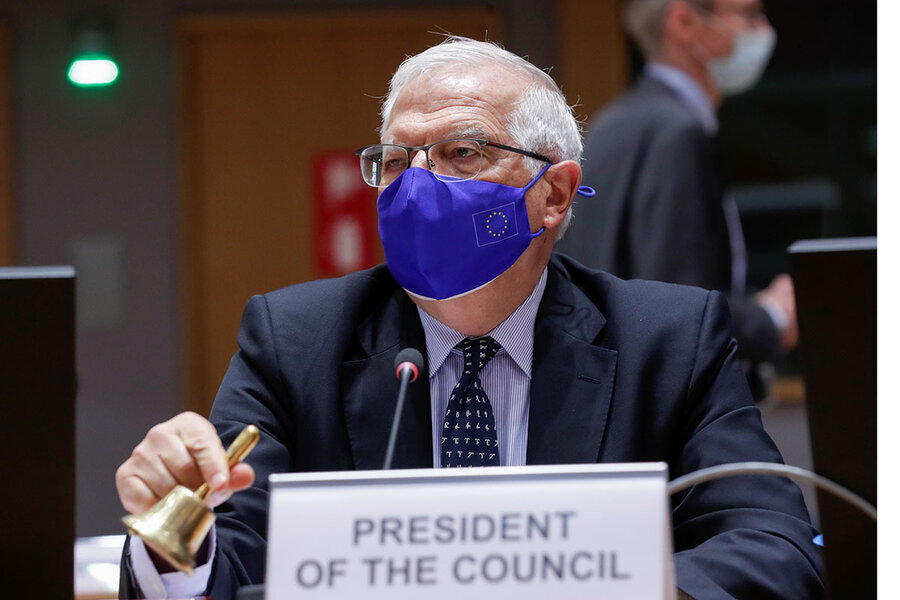
On Monday, British Prime Minister Boris Johnson called on Israel to act more proportionately as it pursues its bombardment of Gaza – a stance that was viewed by some as tinged with frustration that the U.S. has blocked three United Nations Security Council resolutions calling for an end to the violence.
Citing a U.N. report tallying Israeli strikes on 23 schools, 500 homes, and medical facilities, Mr. Johnson’s spokesman Max Blain said, “Israel must make every effort to avoid civilian casualties and military activity must be proportionate.”
Europe is seen by some to be testing the waters of a new reality where the U.S. is no longer the dominant power it once was. “The motto is still very much ‘peace can’t happen without the U.S.’ But nor can it happen with only the U.S.,” says Hugh Lovatt, Middle East policy fellow at the London office of the European Council on Foreign Relations.
While European pressure for a more nuanced U.S. approach is not wholly new, it comes as Mr. Biden faces unusual and mounting pressure from within his own political party to show more support for Palestinians who as usual are suffering disproportionately from the fighting.
“Do Palestinians have a right to survive?” progressive Democratic House member Alexandria Ocasio-Cortez tweeted Saturday in what was a direct rejoinder to President Biden’s focus on Israel’s right to defend itself in the current conflict. “If so,” she added, “we have a responsibility to that as well.”
The tweet came on the heels of a letter to Mr. Biden, signed by progressive congressional Democrats, accusing him of “taking the side of the [Israeli] occupation” of Palestinian territories.
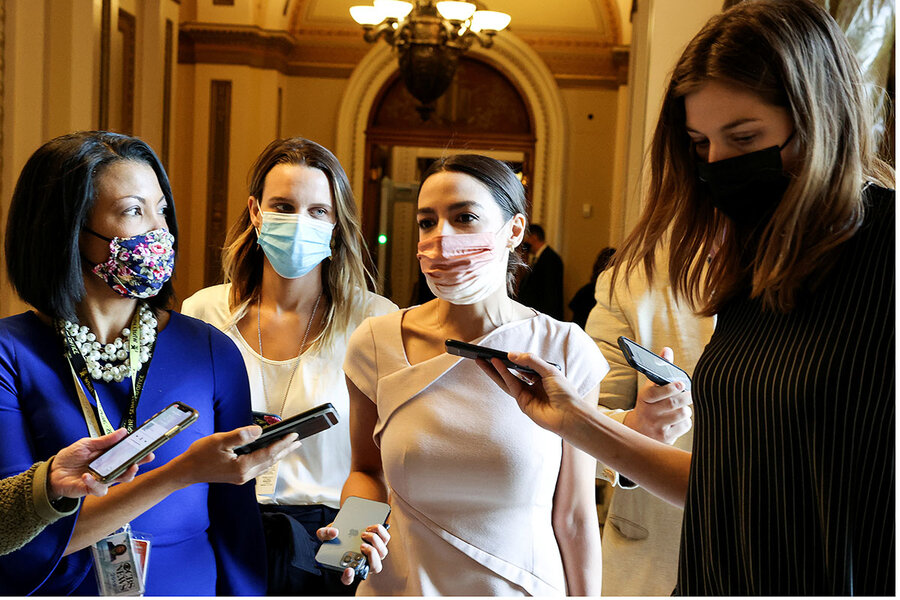
Few observers expect Mr. Biden to bend in his support for Israel in addressing the current conflict. The real question, some say, will be whether the president acknowledges this political pressure by modifying his hands-off approach to the broader Israeli-Palestinian conflict once a cease-fire is secured.
“Can [the administration] go back to business as usual with calls from the left flank of its own Democratic Party to address and resolve this conflict, and specifically in some quarters to do so by reforms through a human rights lens?” posits Lucy Kurtzer-Ellenbogen, director of the Israeli-Palestinian conflict program at the U.S. Institute of Peace (USIP) in Washington.
“We need to be ... fireproofing”
Where a wide spectrum of analysts appear to agree is that the Biden administration won’t be able to simply “go back” to its initial instincts to set aside the Israeli-Palestinian conflict as unripe for U.S. engagement.
“Returning to the wider status quo ante will only guarantee future flare-ups,” says the European Council’s Mr. Lovatt, whose call for a “rights-based strategy” to replace the “current reality of unequal rights and occupation” finds echoes in the U.S. Democratic Party and among a growing number of European officials and regional analysts.
Indeed what Duke’s Professor Jentleson sees happening in the Biden administration is an awakening to the reality that the unresolved Israeli-Palestinian conflict is never safely ignored.
“They’re going to have to say, ‘We have to stop kidding ourselves. This is a process that is going to take more of our bandwidth than we thought,” says Mr. Jentleson, who says that reevaluation will likely mean naming of a high-level special envoy with access to the Oval Office.
While no one foresees a full-fledged peace process taking up final-status negotiations any time soon, Ms. Kurtzer-Ellenbogen of USIP says the U.S. is going to have to get back in the business of nudging the parties toward practical solutions to the security, political, and economic issues building up like ominous thunder clouds.
“If we don’t want to find ourselves in that constant pendulum swing from fire-fighting to ignoring … we need to be in the active business of fireproofing,” she says. “That’s going to be the question for the administration as it moves forward.”

A deeper look
Equal pay for equal work in Europe? The key may be transparency.
A sea change in thinking about gender equality – and a powerful woman at the top – mean the European Union might realize a long unfulfilled goal: equal pay for equal work.

- Quick Read
- Deep Read ( 9 Min. )
While the equality of men and women was a founding principle of the European Union, the continent’s gender pay gap has long been stuck at 14%.
This year, a spate of powerful new efforts by a number of member states to close the gender pay gap has culminated in European Commission President Ursula von der Leyen’s proposal for sweeping new legislation that would compel companies throughout Europe to share salary data broken down by gender and prohibit them from asking job applicants their salary history.
That transparency will make a huge difference, says Henrike von Platen, who launched the Fair Pay Innovation Lab nonprofit to help businesses audit their pay parity. Most companies believe they’re paying their employees fairly, and are surprised to learn they’re not, she says. “Most bosses want to do the right thing, not suck the last honey out of a person for as little as they can get it.”
The jolt they get when they discover that they are part of the gender pay gap problem is what inspires many companies to make a change, she adds. “I’ve had one experience where a CEO goes, ‘Stop – that’s not possible!’” when learning that they had paid women less than male peers. “It’s great. This is really what you want – that moment.”
Equal pay for equal work in Europe? The key may be transparency.

Henrike von Platen was intent on fighting gender discrimination, but she couldn’t shake the feeling that tools like unconscious bias training and diversity workshops were akin to “someone letting us play in a corner, doing kindergarten stuff.” A financial expert, she decided that the key to equality was increasing women’s wages, which consistently lag 20% behind men’s in her native Germany.
So when the German government passed legislation in 2018 requiring larger companies to tell women how their salaries stacked up against male employees’, on average – if they asked – it seemed like a win.
There was a problem, though. Two years later, only 4% of employees had made any such inquiries. Analysts had a hunch as to why: “It put all the burden on women’s shoulders – and many get stigmatized the minute they ask the question,” says Ms. von Platen.
She decided to invite CEOs to take part in a rigorous inspection of their pay structure that would – through transparency – ultimately establish their bona fides as fair payers. The willingness of growing numbers of companies to voluntarily get on board with the nonprofit she subsequently formed, the Fair Pay Innovation Lab, has catapulted the campaign to national acclaim, earning kudos from the German minister of labor.
“If we don’t close pay gaps, women will never reach the same level of power and decision-making as men,” Ms. von Platen says. “I really want to see that happen. Before I die.”
This growing sense of urgency, driven in part by the inequalities the pandemic has laid bare, is helping to usher in a wave of pay transparency measures throughout the European Union.
While the equality of men and women was a founding principle of the EU, the continent’s gender pay gap has long been stuck at 14% – and double that when pensions are taken into account.
This year, a spate of powerful new efforts by a number of member states to close the gender pay gap has culminated in European Commission President Ursula von der Leyen’s proposal for sweeping new legislation that would, among other things, compel companies throughout Europe to share salary data broken down by gender and prohibit them from asking job applicants their salary history.
Lack of pay transparency has long created a gray zone favoring the perpetuation of gender bias, Dr. von der Leyen argued in March. “Women must know whether their employers treat them fairly. And when this is not the case,” she said, “they must have the power to fight back.”
“Most bosses want to do the right thing”
As the EU’s first female president, Dr. von der Leyen has prioritized gender equality in a way her male predecessors haven’t, but she is also taking advantage of a shift in the societal zeitgeist surrounding the basic decency of equal pay.
It was a revelation from the highest levels of the BBC, the venerable news outlet, that helped catapult the issue into the public eye back in 2017, when – as part of its funding agreement with the British government – the company was compelled to make its salary data public. It turned out that just two of its top 14 earners were female, and that the top-paid man was earning more than 2.2 million pounds ($3.1 million), while the top woman – the 8th-ranked earner overall – was making some 450,000 pounds ($624,000). Two of the BBC’s international editors were shown to be making more than 50% more than their female counterparts.

During a lawsuit brought by television presenter Samira Ahmed, who was making 12% of what a male colleague earned, BBC lawyers argued that their work was very different, since the man’s job required him to be like a “concert pianist in a concert hall,” while Ms. Ahmed’s role was like “someone playing piano to a ballet class of 10 children.” Ms. Ahmed won her lawsuit.
In an equally high-profile case still being fought, the U.S. women’s national soccer team used the transparency that comes with sports star earnings to sue the U.S. Soccer Federation. The players have accused the federation of discrimination over the discrepancy between their income and that of the U.S. men, who get paid more but have earned far less international success than their Women’s World Cup-winning peers. The campaign caught the attention of then-presidential candidate Joe Biden, who tweeted, “To @USSoccer: equal pay, now. Or else when I’m president, you can go elsewhere for World Cup funding.”
For Lasse Rheingans, founder and CEO of digital development firm Rheingans, the sense of injustice he felt in hearing about these cases collided with a practical outlet for clear action after he met Ms. von Platen at a conference in Berlin.
Discussing the gender pay gap with her over a high-top table in a hotel lobby, Mr. Rheingans recalls thinking, “I just can’t cope or understand it, how people can be so – perhaps, mean? – as to accept this.”
He had sold his shares in a former company in 2017 to start his own enterprise. Back then, he says, “I earned more money – but I managed to spend it all without being happier.”
In his new company, Mr. Rheingans wanted to try different ways of doing business around “how would we like to work and live in the future – what is important, and what really matters?”
To this end, he pioneered a 5-hour workday for his full-time employees, garnering considerable press coverage. In the process, “I got so many messages from managing directors at midsize companies being so thankful, because they realize that they’re not alone in questioning the status quo.”
When Ms. von Platen asked him if he would like to embark on an analysis of salaries in his company to check for gender bias, “I was like, ‘Yes!’ straight away,” says Mr. Rheingans.
His expectation is that “we don’t have any pay gap at all, because I don’t differentiate between men and women with regard to payment.” But Mr. Rheingans is also open to evidence to the contrary, acknowledging the countless studies showing that women tend to undervalue their skills, ask for less money, be more reluctant to negotiate and, when they do, be met with less success, largely because women who request – or, as it’s often put, “demand” – more money are often seen, consciously or unconsciously, as less likable than men who do the same, especially when they’re women of color.
“Today, we have so many jobs that are so specific and – I’ve experienced it myself – I have no clue sometimes what I should pay. It’s nothing I do with bad interest. If a woman asks for 40,000 euros and a man asks for 50,000, I didn’t set out to pay a woman less,” says Mr. Rheingans. “This is the good thing about this process – you can find things that you do unintentionally. Maybe we haven’t found out about it yet – perhaps we’ll find out about it soon.”
Most companies believe they’re paying their employees fairly, and are surprised to learn, in fact, they’re not, Ms. von Platen says. “That’s the main culture, I’d say – most bosses want to do the right thing, not suck the last honey out of a person for as little as they can get it.”
The jolt they get when they discover that they are part of the gender pay gap problem is what inspires many companies to make a change, she adds. “You have this moment where they’ve done the analysis, and the figures for the pay gap come up on a power point slide. I’ve had one experience where a CEO goes, ‘Stop – that’s not possible!’ It’s great. This is really what you want – that moment.”
The effects of transparency
Such moments may be coming for growing ranks of companies. Between 2018 and 2020, the number of national laws requiring employers to take legislative steps towards reducing the gender pay gap has more than doubled, from 6 to 13 countries, including France, Ireland, the Netherlands, Portugal, Spain, and Switzerland.

The common thread running through all the measures is a requirement that firms with anywhere from 50 to 150-plus employees carry out a gender pay gap analysis and report it to the government – though this information is not always made public, according to PwC research. Other countries, including the United Kingdom and Germany, do not impose any financial sanctions for noncompliance.
France’s new legislation took effect in March 2019, for example, requiring firms to publish their global score against a 100-point scale “gender equality index.” The year after the law took effect, the average score among businesses with more than 1,000 employees increased from 83 in 2019 to 87 in 2020; those with 250 to 1,000 workers saw their index scores rise from 82 to 85. Roughly 2% of businesses scored 100 points. The higher the score, analysts argue, the more attractive a company will be to employees.
And the better paid women will be. This is in line with U.S. studies that conclude that women in states like California that have transparency measures – for example, outlawing demands that employees not discuss their salaries, under threat of termination – have higher earnings.
Even seemingly small increases in women’s wages have outsize benefits, according to the EU’s Joint Research Center, which calculates that a 3 percentage point drop in the gender wage gap would substantially decrease the poverty risk for single-parent households.
Such considerations are particularly urgent amid the pandemic, when women have taken on the bulk of caring responsibilities prompted by the closure of schools and fear of nursing homes, “endangering hard-fought progress towards gender equality,” the European Commission warns.
At the same time, the crisis has “exposed the deep-rooted bias behind wages for professions dominated by women, with carers and cleaners recognized as ‘essential’ despite being amongst the lowest paid,” notes Esther Lynch, deputy general secretary of the European Trade Union Confederation, which represents 45 million European workers. “It breathed life back into the old demands of equal pay for work that is massively undervalued.”
“We can no longer ignore the bad state of affairs”
Beyond basic decency, analysts add, there’s a mercenary argument for companies as well: Research shows that employees are more productive when salaries are transparent.
In the past, Maxi Jaschinski felt undervalued by employers. “I saw hierarchies, stereotypes, gender pay gaps – to put it in a nutshell, you are often not that respected when you are a young woman,” she says. “You have to work much harder than your male colleagues to reach your goals. That’s frustrating.”
When she learned that Rheingans, her current employer, would be taking part in the Fair Pay Innovation Lab’s audit, “This felt like another step for gender equality,” she says. “It’s not only talking about how we’re all equal, that we share tasks and responsibilities – but we also share money.”
Today, Ms. Jaschinski says she feels more than well-compensated. “I feel really, really inspired.”
Companies’ response to inequities revealed through transparency can help them stand out – or not. When the U.K.’s reporting requirements revealed that budget airline Ryanair had a gender pay gap of 72% – with women making up 3% of the top quarter of earners – the all-male senior management board responded that this was simply due to the fact that most pilots are men and that, hopefully, more women would apply in the future.
By contrast, Ryanair rival EasyJet, whose 45% pay gap had also attracted widespread criticism, pledged that at least 1 in 5 of its new pilot recruits would be women by 2020, and embarked on a series of staff surveys. These revealed that while most male pilots had decided on their careers by age 11, with much encouragement, women didn’t receive similar childhood cheerleading. The airline announced a partnership with a girl scouting organization to sponsor an aviation badge.
With an eye on the bottom line, EasyJet’s CEO also took a $48,000 pay cut to match the salary of his female predecessor.
Despite the stereotypes of mercenary corporations out to save a buck, Mr. Rheingans argues that a younger generation of CEOs, in addition to running successful businesses, are actually interested in issues like equality and fairness.
“To bring about long overdue change, we can no longer ignore the bad state of affairs – we have to clearly call it out,” he says. “I’m willing to give profits towards making it so my employees are healthier, happier, and stay on board longer,” he adds. “It’s way better than having the next 1,000 euros in my account.”

Stepping Up
From LA jail, two inmates pioneer care for mentally ill peers
From the squalid conditions of the Los Angeles County jail has emerged a potential model for how to address mental illness. The secret? Administering regular doses of brotherly love.

- Quick Read
- Deep Read ( 8 Min. )
The Los Angeles County jail holds an unofficial title: the nation’s largest mental health institution.
And on the fourth floor of Tower 1 is a program that both law enforcement and mental health professionals say could be a model for more humane and effective treatment.
It’s a homegrown approach, developed by the on-site psychiatric technician, Sarah Tong, and taken to a new level by two “merit master” inmates from the general jail population, Craigen Armstrong and Adrian Berumen. With the support of Ms. Tong and others, they created a role as mental health assistants – living among those who are most severely ill, encouraging them to take medication (but not administering it), updating health professionals and custody officials on behavior, and adding more structure to a program that uses incentives to teach basic hygiene and other life skills.
Most important, the duo express consistent love and care toward the men. “It’s so simple, it’s profound,” says Joan Hubbell, the mental health programming manager for county correctional health services. “They so understand how badly they want to be given a second chance and don’t want to be dismissed by people’s preconceived notions of them. It drives them to give [others] a second chance.”
From LA jail, two inmates pioneer care for mentally ill peers
With more than 5,000 inmates struggling with mental health issues, the Los Angeles County jail is the largest jail system in the United States. It also holds another unofficial title: the nation’s largest mental health institution. That jail population has more than doubled in the past 10 years, with the imposing Twin Towers facility for men in downtown Los Angeles now devoted almost entirely to mental health inmates under “moderate” or “high” observation.
The men in high observation – numbering about 1,000 – reside in Tower 1.
When they are not in their cells, they are handcuffed to metal tables so they can’t harm themselves or others, and many are dressed in quilted robes to prevent self-harm. They live in pods of 16 cells that are often noisy and foul-smelling. As Joan Hubbell, the mental health programming manager for county correctional health services, admits, staff can’t keep up. Indeed, the jail operates under Department of Justice monitors to meet criteria for the treatment of mental-health inmates.
But three pods on the fourth floor hold out hope for more humane and effective treatment. Officials are working to expand the nascent effort, affecting about 70 men in jail, to other floors, and some see it as a model for the nation. It’s a homegrown approach, developed by the on-site psychiatric technician, Sarah Tong, and taken to a new level by two “merit masters” from the general jail population, Craigen Armstrong and Adrian Berumen. With the support of Ms. Tong and others, they created a unique role for themselves as mental health assistants – living among those who are most severely ill, encouraging them to take medication (but not administering it), updating health professionals and custody officials on behavior, and adding more structure to a program that uses incentives to teach basic hygiene and other life skills.
Most important, the duo express consistent love and care toward the men. “It’s so simple, it’s profound,” says Ms. Hubbell. “They so understand how badly they want to be given a second chance and don’t want to be dismissed by people’s preconceived notions of them. It drives them to give [others] a second chance.”
The results are beyond the expectations of everyone, from a top assistant sheriff for the county to the mental health professionals. Self-harming is six times less, compared with other units, according to Ms. Hubbell. Discharging the incarcerated men from the forensic inpatient hospital to this program, known as Forensic Inpatient (FIP) Stepdown, has reduced returns to the hospital by 35%. Beyond the data, you can see the difference in the patients’ eyes and relaxed faces, she says. Outside their cells they are uncuffed (a deputy is always present), attending group therapy, and working as a team on “double scrub” Mondays, when Mr. Armstrong and Mr. Berumen assign chores to clean the two-story pods from top to bottom.

“When you walk in there, it doesn’t smell. It’s not noisy; it’s clean. People are not freaked out in their cells. They’re not bashing their heads against the walls. They’re not throwing their feces,” says Philippe Bourgois, a professor of psychiatry and anthropology at the University of California, Los Angeles who leads the Center for Social Medicine there. He volunteers at Twin Towers and is one of several key people, including FIP Stepdown’s director, Ms. Tong, who helped the two inmates build knowledge about mental illness.
“What people don’t understand about mental illness is that you become a social outcast,” says Professor Bourgois. The “brilliant insight” of the two inmates is that they figured out that human beings hate to be alone. They need friends. The assistants have already helped hundreds of people, he says. “This program has truly national and international potential for being a model.”
It was the idea of a jail captain to tap the men’s city jail for merit masters – inmates who have completed educational courses and can teach others – and bring them to Twin Towers. Prisons and jails run on inmate labor, but nothing like this, according to the National Association of Counties, which in 2020 honored the program with an achievement award. Peer-to-peer support from outsiders who are in recovery themselves is not unusual. But this is an inside job. As fellow inmates, Mr. Armstrong and Mr. Berumen are on hand 24/7, building trust and hearing and seeing things that others don’t. They bridge the gap between those struggling mentally and the health professionals and guards overseeing them, say those involved in the program.
More than just helping out, the two men sought to understand the experiences of those around them. Most are poor and homeless, and many have schizophrenia, says Ms. Tong. The vast majority are chronic methamphetamine users. Their offenses range from trespassing to murder.
Daily checklists hang outside each cell door: “AM Meds, Teeth, Shower, Clean Housing, Group, PM Meds, Monday Scrub.” Completing all in a week earns a person specially prepared meals on weekends. The “five-star” meals are a huge motivator, as are food and snacks generally – with coffee a favorite, and Dinty Moore Beef Stew a rare treat. Because they spend so much time with those behind cell doors, Mr. Armstrong and Mr. Berumen know what reward means the most to each one.

The two men spent weekend after weekend refining a curriculum on lifestyle habits, understanding the court, and self-education, which covers things like interpersonal communication. The nine-week course culminates with a graduation ceremony.
And they help facilitate group therapy sessions and therapeutic activities, like group karaoke and making colorful banners with inspirational messages. The banners hang in the pod common area, which Ms. Tong has made more homelike with huge, plastic rocking chairs, live plants, and a miniature fish tank with blue and red betta fish. Next on her list: an herb garden in the outdoor recreation area.
But is it possible to scale up something like this, which depends not only on teamwork, but also on the character and skill of inmate mental health assistants, who act as mentors?
Last year, Mr. Armstrong and Mr. Berumen self-published a book, “The Solution: Mental Health Assistants.” This road map to the program, which also covers the training of assistants, was written entirely with 3-inch pencils. It was formatted and brought to fruition by Kerry Morrison, the founder of Heart Forward LA, which advocates “radical hospitality” to transform America’s mental health system. In November, she posted a podcast interview with them and last month moderated a Zoom panel discussion about the program.
The Monitor was not able to talk with the two men directly, because their lawyers advised against it. According to court documents, Mr. Berumen is awaiting trial on June 2, facing charges of attempted murder, murder, and arson. After having his previous judgment overturned due to a juror issue, Mr. Armstrong is heading for a retrial Aug. 9 on multiple counts of murder, among other charges. A pretrial hearing is set for June 16. The prosecution is no longer seeking the death penalty for Mr. Armstrong.
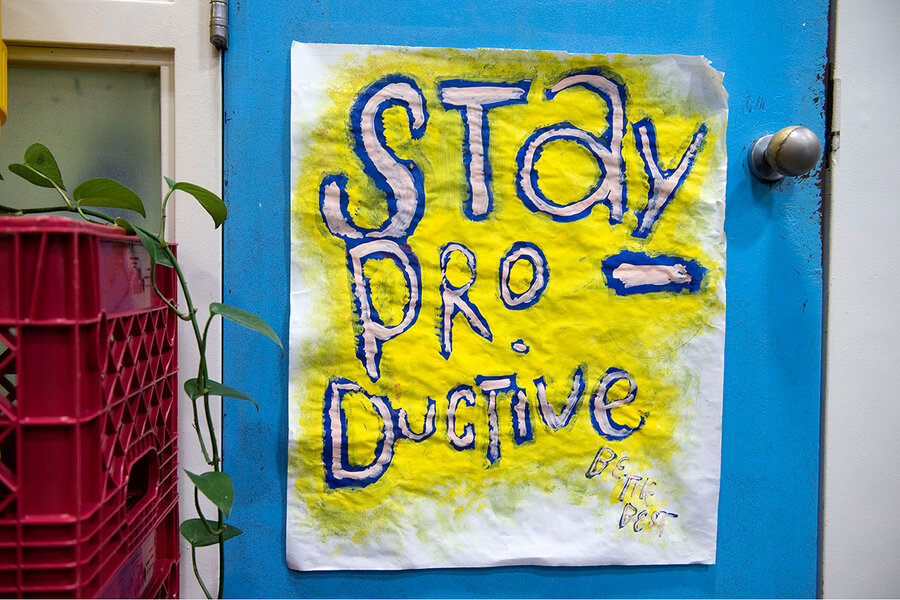
In their discussions with Ms. Morrison, the two men talk extensively about what it takes to be a mental health assistant. “It’s a challenge living in the pod,” said Mr. Armstrong on the Zoom recording. “You’re being assaulted. You’re being disrespected a lot, and you have to figure out other ways on how to deal with that. ... But it takes a lot of self-restraint, a lot of tolerance, a lot of understanding, a lot of communication to treat the individual the way they should be treated.” He has spent hours outside a jailed patient’s cell door, just talking to that person.
Mr. Berumen says they look for keys when interviewing potential assistants. They must have completed three education courses, preferably one on anger management. How’s their appearance – are they combing their hair? Perhaps someone has a spiritual side. But the main thing they want to know is what challenges a person in jail has faced, and how he dealt with them. “We kind of know when a guy is pulling something over,” said Mr. Armstrong, in the November podcast.
With a combined 25 years incarcerated, they’ve had time for inner reflection. Both men emphasize the redemptive nature of this chapter in their lives. “I think the individual is created to grow,” said Mr. Berumen, the younger of the two, in the podcast. “The perfect opportunity to redeem yourself is to give back.” Everybody wants to be valued in life, he explained. “After so long, you start to look and you long to be of value to somebody, and then you start to see the individuals who do need you. And you find value.”
The program has had mixed results with other mental health assistants, according to Ms. Tong. That has slowed progress. But more recently, officials let Mr. Armstrong and Mr. Berumen interview close to a dozen men in jail, completely on their own, and “the two they chose are amazing.” The new assistants are in a third pod and the program is close to expanding to a fourth. “It’s going to take a lot of time, and it takes a specific kind of person to do it,” says Ms. Tong, of plans to expand.
“The whole idea of trying to replicate it and export it to other institutions and states and agencies is still in its infancy,” says Assistant Sheriff Bruce Chase, the law enforcement support behind the idea of mental health assistants. Best of all is to divert – or release – mentally ill people from prisons and jails into more appropriate settings, say both corrections and mental health experts. Los Angeles County does this to some extent, but treatment solutions are lacking in the community, according to Assistant Sheriff Chase.
“We have all these individuals accused of various crimes, ranging from minor to extremely serious, and we’re forced to deal with them in a jail setting rather than a mental health one,” he says. So the effort to expand the mental health assistant program continues, including bringing it to the county’s incarcerated women – a population of about 1,200, he says, where nearly 70% have been identified as having some level of mental health challenge.
“We have to start somewhere. If you think about trying to help everyone, you get overwhelmed and then decide you can’t do it because it’s too much,” he concludes. “If you incrementally do it, you can see the success and it becomes achievable in your mind. As we expand it and see the success, hopefully we can help a lot more folks.”

Ponytails and braids: Signs of a more inclusive US military
What may seem like a superficial change in grooming standards signals a dramatic change in attitudes about military strength.

- Quick Read
- Deep Read ( 5 Min. )
In January, the Air Force changed grooming standards for female troops to allow ponytails and braids rather than buns alone. The Army followed suit a few months later, announcing that it is also eliminating from policy guidance words like “eccentric” and “faddish,” which often targeted women of color.
“This really goes back to a larger thing – diversity and inclusion,” Sgt. Maj. of the Army Michael Grinston said. “Are these microaggressions, those things that we were saying that maybe we didn’t know were offensive? Maybe we need to be aware of that.”
The new hairstyle options will also keep women safer. Buns sometimes caused helmets to tip forward, and they made getting a good seal on a gas mask nearly impossible.
Yet what’s making headlines is the shift in thought about how a soldier should look.
“Hair can be seen as a cosmetic thing,” says Maj. Kelly Atkinson, an assistant professor at the U.S. Air Force Academy, “but it’s also a way to recognize that service members come from different genders, different identities. Usually there’s this assumption that masculinity is strength and femininity is weakness. My answer is that the military doesn’t have to be masculine to be successful.”
Ponytails and braids: Signs of a more inclusive US military
On a Pentagon stage earlier this year, three senior noncommissioned officers – all men – discussed the merits of changing the Army’s appearance regulations for women.
The town hall, broadcast online, turned to whether women should be allowed to wear stud earrings. “I’m just going to be honest: If you’d asked me before, I would’ve said, ‘No, why do we need earrings?’” said Sgt. Maj. of the Army Michael Grinston.
But task force testimony from behavioral health specialists helped the men see the matter differently, Sgt. Maj. Mark Clark added. “I will tell you, we learned quite a bit” about how old policies affected women “in a masculine Army.” Earrings “kind of helped bridge the gap” for those “who want to serve and be soldiers, but also want to feel like a female at the same time.”
It was a town hall convened to announce sweeping changes to what are known as Army grooming standards, including allowing women to wear ponytails and braids rather than buns alone, and eliminating from policy guidance words like “eccentric” and “faddish,” which “seem to target a specific demographic” of women of color, an Army PowerPoint slide noted.

“This really goes back to a larger thing – diversity and inclusion,” Sergeant Major of the Army Grinston told the town hall. “Are these microaggressions, those things that we were saying that maybe we didn’t know were offensive? Maybe we need to be aware of that.”
“Roger that,” said Sgt. Maj. Brian Sanders, the third man on the panel, who cautioned that the military must guard against “weaponized wording” as well as “clarify what do we mean by ‘professional’ appearance – that is such a subjective term.”
It was an extraordinary exchange among senior noncommissioned officers, who concluded that maybe it’s all right for women to be feminine – or unfeminine, or “eccentric” – in a masculine environment.
And while the revamping of Pentagon regulations related to hair, nails, and jewelry is the first such major change in many years, the larger cultural shift within the U.S. military, analysts say, is how this is expanding ideas about what a soldier should look like in the first place.
“Hair can be seen as a cosmetic thing, but it’s also a way to recognize that service members come from different genders, different identities,” says Maj. Kelly Atkinson, assistant professor of political science at the U.S. Air Force Academy. “Usually there’s this assumption that masculinity is strength and femininity is weakness. My answer is that the military doesn’t have to be masculine to be successful.”
Reactions beyond the military
That remains a threatening idea in many camps. Fox News host Tucker Carlson notoriously attacked new maternity uniforms in a March broadcast, deriding them for making a “mockery of the U.S. military.”
Such notions have been in place since women have been in uniform. In addition to their other duties, they have been expected to walk a fine line between being too feminine – thus raising questions about whether they joined the service to steal some husbands – and being too masculine, risking accusations that they’re just trying to be men, with all the shame those propositions are meant to imply.
What made this decadeslong critique raised by Mr. Carlson different is the way military men quickly joined women in the ranks to set the record straight.

Perhaps Mr. Carlson feels he has “something to prove,” Pentagon press secretary John Kirby, a retired rear admiral, speculated in comments some interpreted as subtly alluding to Mr. Carlson’s lack of military service. In any case, commanders would not be taking “personnel advice from a talk show host,” he added. The Pentagon’s internal press service proclaimed, “Press Secretary Smites Host That Dissed Diversity in U.S. Military.”
Mr. Carlson wasn't the only critic, as Maj. Alea Nadeem, an intelligence officer in the Air Force Reserve, can attest. “We also got some comments like, ‘Oh, you’re just trying to look cute,’” she says. “I can assure you that’s not the case.”
The benefits of braids over buns
Indeed, the changes, officials discovered, are eminently practical and potentially lifesaving. When Major Nadeem was out on the firing range years ago, for example, she wore her long, thick hair in a regulation bun. The problem was that the bun was tipping her helmet forward, making shooting accurately a problem.
She asked instructors if she could undo her hair and tuck it into her collar. “They were like, ‘Sure, whatever you need to do to shoot.’” Afterward, she recalls thinking about what would happen if she was really at war.
Now, as Women’s Initiative team chief for the Air Force’s Barrier Analysis Working Group, Major Nadeem leads the task force that lifted the ban on a number of hairstyles in January, allowing women to wear ponytails and braids, just weeks before the Army followed suit with its own historic changes. These changes, which also include scrapping minimum hair length requirements for women, officially went into effect for soldiers earlier this month.
“Before when they wore their helmets to fly, our female aviators had to take their hair down from a bun and put it in two braids so the helmet would fit. So in order to fly their aircraft, they had to be out of standard,” notes Major Nadeem.
Then there were the gas masks. “The first thing they tell you when you’re female is ‘Take your hair down, because there’s no way you’re going to get a good seal with that bun.’”
In further acknowledgment that the lack of hairstyling options was unhealthy, military officials brought in dermatology consultants and found that one-third of Black female troops were experiencing hair loss, and more than half of women ended their days with tension headaches.
Still, some of the strongest voices against change were servicewomen themselves. “A senior female officer said, ‘Hey, I had headaches too, but I made the choice to cut my hair because I love my country,’” Major Nadeem recalls. “I said, ‘Wouldn’t it be nice if you could serve your country and have your hair?’”
Today, commanders are gradually coming around to such dualities. “I think that’s what I really learned this last year,” Sergeant Major of the Army Grinston told the town hall. “And I was at fault in this: I used to say, ‘We’re all soldiers; I just see green.’” That said, he explained, “not only are you a soldier, but there are other pieces of you that are critical.”
“It’s OK to stand out,” he added. “If people judge you for that, they need to be corrected – not you.”

Books
Traveling (at last)? Take along the 10 best books of May.
“All things seem possible in May,” wrote American naturalist Edwin Way Teale. Our picks for this month transport readers through a bountiful landscape of books that enliven and illuminate.

- Quick Read
- Deep Read ( 3 Min. )
-
By Monitor reviewers
As the world begins to reopen to possibilities such as traveling, nothing compares to having a book along for the ride. This month provides a generous duffle-bag worth of titles to explore and share. The fiction choices include novels about the immigrant experience and finding a wider sense of family. In nonfiction, the books range from American history to forest ecology to the U.S. Secret Service.
Traveling (at last)? Take along the 10 best books of May.

From a novel about difficult beginnings to a memoir that traces exercise fads, and from Napoleon’s art lust to trees that communicate, May books traverse a wide territory.
1. Things We Lost to the Water by Eric Nguyen
This debut novel spans three decades in the lives of a Vietnamese immigrant family that escapes war and communism to settle in New Orleans without the father – who has disappeared. Eric Nguyen exquisitely captures the nostalgia of childhood, the problems facing refugees, and the search for healing when secrets rock the soul.
2. Monkey Boy by Francisco Goldman

In this semi-autobiographical novel, Francisco Goldman writes about a journalist with a Guatemalan mother and a Russian Jewish father, who grew up in Boston feeling like an outsider. Returning home to the United States after a decade in Mexico, he reconnects with a high school sweetheart, but his visit also exposes bitter memories of school-age bullying and a violent father. In this beautiful but sometimes wrenching story, Goldman uses humor to explore identity.
3. The Guncle by Steven Rowley

Steven Rowley hits the sweet spot between hilarity and heart in this novel about a sitcom star who becomes the reluctant – and unconventional – caretaker of his niece and nephew. The siblings are grieving their mother’s death, and their father has gone into rehab, so Gay Uncle Patrick (aka GUP) takes them in.
4. The Secret to Superhuman Strength by Alison Bechdel
Cartoonist Alison Bechdel tackles her obsession with exercise as the means of transcendence over various personal hurdles in this graphic memoir. In tracking her pursuit of self-improvement, strength, and enlightenment, she pulls off a remarkable balancing act between a personal quest and a fascinating overview of fitness fads over years.
5. On Juneteenth by Annette Gordon-Reed
Pulitzer Prize winner Annette Gordon-Reed renders a perfectly quilted work of history seen through the eyes of an African American family in Texas. It follows the seldom-shared stories of descendants of enslaved Black people from the 1820s to their emancipation in Galveston on June 19, 1865.
6. Finding the Mother Tree by Suzanne Simard
Suzanne Simard is a leading forest ecologist and a pioneer in the field of plant communication. She writes that trees are complicated, interdependent social organisms connected to one another through underground networks. This book is not just about the science, but about a deeply personal quest to understand one of the most dominant classes of species on Earth.
7. Plunder by Cynthia Saltzman
Napoleon Bonaparte, one of history’s most prolific art looters, plundered famous works from across Europe to stock the newly created Louvre Museum. In this fascinating tale, art historian Cynthia Saltzman describes how he stole one of Venice’s most important paintings and why, 225 years later, it remains in Paris.
8. The Words That Made Us by Akhil Reed Amar
Akhil Reed Amar’s fresh and fascinating book focuses on the explosion of impassioned discourse that culminated in, and followed, the ratification of the U.S. Constitution. As the title suggests, the book elevates the importance of dialogue and debate in cementing American identity.
9. African Europeans by Olivette Otele
Olivette Otele unfolds the long history of Africans in Europe, adding personal and social dimensions to the sometimes thin accounts that have been the standard. Her cast of characters is as broad as her canvas, and by redrawing the centurieslong story of African immigration, her book changes how European history is understood.
10. Zero Fail by Carol Leonnig
Carol Leonnig’s riveting book about the U.S. Secret Service surveys the agency’s history but concentrates on the period starting with the agency’s worst and most public failure: the 1963 assassination of President John F. Kennedy. In Leonnig’s telling, it’s all down-hill from there. She interviews dozens of present and former agents to tell a story of institutional rot that’s as fascinating as it is alarming.
Other headline stories we’re watching
(Get live updates throughout the day.)The Monitor's View
The peace that wears on the Hamas-Israel war
- Quick Read
- Deep Read ( 2 Min. )
-
By the Monitor's Editorial Board
After days of Israel-Gaza violence, the Arab citizens of Israel and Palestinians on the West Bank did something peaceful Tuesday. They went on a one-day general strike in solidarity with Palestinians in East Jerusalem who are using legal means to claim land they have lived on for decades. Instead of throwing stones or launching rockets, the strikers boycotted businesses.
In recent days, many Israeli Arabs have joined peaceful protests – often with Israeli Jews – to end the violence and seek solutions to the many issues that divide Palestinians and Israel. As one protester in Haifa, Tawfiq Nagar, told Haaretz, “It’s not a question of national identity but of values. ... We can’t let racism break through again.” Last year, The Associated Press found a growing number of Palestinians “have embraced nonviolent means of protesting Israel’s military rule and expanding settlements.”
While few in number, those advocating nonviolence do not get much attention from journalists. Peaceful tactics, however, can often touch hearts, lessen anger, and promote social change. Like an act of love, they invite an opponent to resolve long-standing issues by relying on just means. When that happens, both sides are enabled to build a relationship that allows for just solutions.
The peace that wears on the Hamas-Israel war
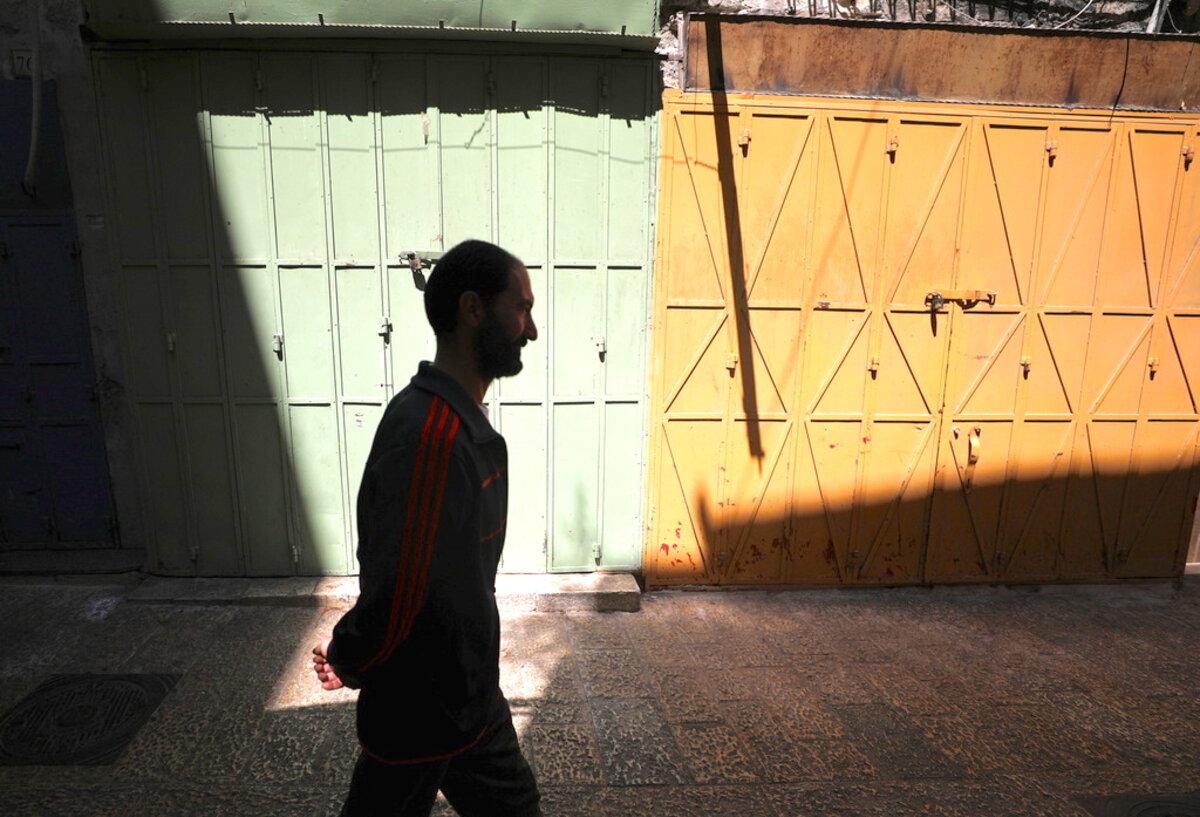
After days of Israel-Gaza violence that has killed hundreds, the Arab citizens of Israel and Palestinians on the West Bank did something peaceful Tuesday. They went on a one-day general strike in solidarity with Palestinians in East Jerusalem who are using legal means to claim land they have lived on for decades. Instead of throwing stones or launching rockets, the strikers boycotted businesses.
The nonviolent tactic was echoed in a little-noticed action by a top Arab politician in Israel, Mansour Abbas. On Sunday, the chairman of the United Arab List coalition visited a burnt-out synagogue in the city of Lod, a mixed Arab-Jewish city that was the scene of violent clashes after the outbreak of the latest Hamas-Israel war.
“We must begin rehabilitating the synagogue in Lod,” the Arab leader said. “Even in times of war, Islamic values forbid harming holy places.” He advocated for a healing after the violence.
In recent days, many Israeli Arabs have joined peaceful protests – often with Israeli Jews – to end the violence and seek solutions to the many issues that divide Palestinians and Israel. As one protester in Haifa, Tawfiq Nagar, told Haaretz, “It’s not a question of national identity but of values.... We can’t let racism break through again. This is the time to protest together, Arabs and Jews, against police violence and the occupation, and for peace, otherwise hatred will win again and again.”
Last year, Associated Press found a growing number of Palestinians “have embraced nonviolent means of protesting Israel’s military rule and expanding settlements.” Sometimes peaceful actions do have an impact of Israeli institutions. Last month, for example, a court in Jerusalem imposed a fine against a Jewish settler on the West Bank for slapping a prominent pacifist, Issa Amro, as he was walking Palestinian children to a school in Hebron.
Israeli Arabs and Palestinian who do commit to nonviolent means - such street demonstrations, petitions, or general strikes – often learn they can gain allies among Israel Jews and foreign countries. Such tactics also appeal to those exhausted by violence or who see how violence reinforces radicalism on either side.
While few in number, those advocating nonviolence do not get much attention from journalists. Peaceful tactics, however, can often touch hearts, lessen anger, and promote social change. Like an act of love, they invite an opponent to resolve long standing issues by relying on just means. When that happens, both sides are enabled to build a relationship that allows for just solutions.

A Christian Science Perspective
Each weekday, the Monitor includes one clearly labeled religious article offering spiritual insight on contemporary issues, including the news. The publication – in its various forms – is produced for anyone who cares about the progress of the human endeavor around the world and seeks news reported with compassion, intelligence, and an essentially constructive lens. For many, that caring has religious roots. For many, it does not. The Monitor has always embraced both audiences. The Monitor is owned by a church – The First Church of Christ, Scientist, in Boston – whose founder was concerned with both the state of the world and the quality of available news.
A powerful foundation for respect
- Quick Read
- Read or Listen ( 1 Min. )
-
By Mark Sappenfield
How can we bridge the conflicts that divide us? This short podcast by the editor of the Monitor explores a spiritual basis for respect that fosters healing and progress.
A powerful foundation for respect
To hear Mark’s sharing, click the play button on the audio player above.
For the Monitor’s focus on bridging the conflicts that divide us, see The Respect Project, which examines the graces and complexities of respect in a half-dozen stories being posted this month.

A message of love
Comfort after a border crossing
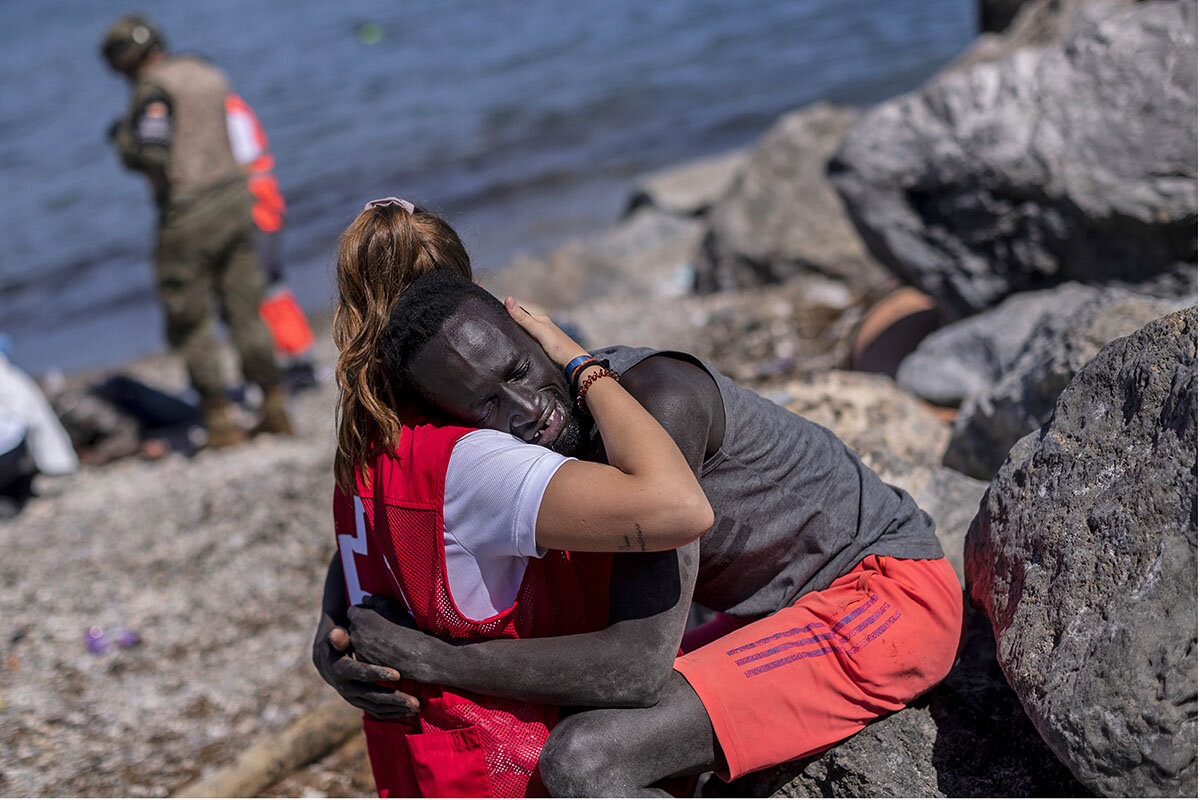
A look ahead
Thank you for joining us today. Before we let you go, we’d like to direct you to a podcast our Mark Trumbull and Stephanie Hanes Wilson did on whether business can bridge the gap on climate change. The podcast is hosted by the Common Ground Committee and can be found here.



